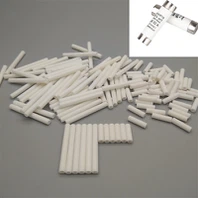Alumina ceramic, also known as aluminum oxide or Al2O3, is a versatile and widely used material known for its exceptional mechanical, thermal, and electrical properties. The manufacturing process of alumina ceramic involves several key steps, each crucial for achieving the desired material properties. Here is an overview of the typical process involved in the production of alumina ceramic.
Raw Material Preparation
The manufacturing process begins with the selection and preparation of raw materials. The primary raw material for alumina ceramic is aluminum oxide powder, derived from bauxite ore through a refining process. The raw material is carefully selected for its purity and consistency to ensure high-quality alumina ceramic production.
Powder Milling
The selected aluminum oxide powder undergoes a milling process to achieve the desired particle size and distribution. This step is critical for controlling the properties of the final ceramic material. The milled powder is then thoroughly mixed to ensure homogeneity.
Forming
The next step involves shaping the alumina ceramic into the desired form. There are various methods for forming, with the most common being dry pressing, isostatic pressing, and extrusion. In dry pressing, the milled powder is compacted into a shape using a mechanical press. Isostatic pressing involves subjecting the powder to high pressure from all directions in a fluid medium. Extrusion involves forcing the prepared material through a die to create a continuous shape.
Green Machining
After forming, the ceramic material is in a "green" state, meaning it is not yet fully dense or hardened. Green machining, also known as pre-sintering machining, is a process where the formed component undergoes further shaping and detailing before the sintering process. This step allows for the creation of complex shapes and precise dimensions.
Sintering
Sintering is a critical step in the alumina ceramic manufacturing process. The green ceramic is heated to high temperatures, typically above 1600 degrees Celsius, causing the powder particles to bond and form a dense, solid structure. The sintering process contributes significantly to the hardness and strength of the final ceramic product.
Grinding and Lapping
The sintered ceramic undergoes grinding and lapping processes to achieve the desired surface finish and dimensional accuracy. These precision machining steps are essential for applications that require tight tolerances and smooth surfaces.
Quality Control
Throughout the manufacturing process, rigorous quality control measures are implemented to ensure the alumina ceramic meets the specified standards. This includes testing for mechanical properties, thermal conductivity, electrical resistivity, and overall structural integrity. Any components that do not meet the quality criteria are rejected or reprocessed.
Finishing and Coating
Depending on the application, alumina ceramic components may undergo additional finishing steps or coating processes. Finishing processes, such as polishing or glazing, enhance the surface properties of the ceramic. Coating may be applied to improve wear resistance, reduce friction, or provide other specific functionalities.
Final Inspection and Packaging
The final products undergo a thorough inspection before being packaged and shipped. This includes visual inspections, dimensional measurements, and additional testing as needed. Proper packaging is crucial to prevent damage during transportation and handling.
In conclusion, the manufacturing of alumina ceramics involves several key stages to ensure their desired properties for a wide range of industrial applications, including electronics, aerospace, automotive, and medical devices. The versatility and reliability of alumina ceramic make it a valuable material in various industries, and the precise manufacturing process plays a crucial role in achieving its exceptional properties.




